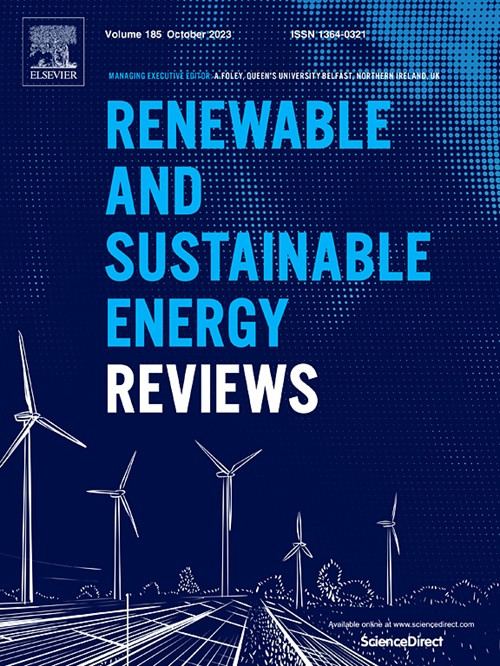Status and perspectives of the hydrate technology for carbon sequestration in permafrost region: A review
IF 16.3
1区 工程技术
Q1 ENERGY & FUELS
引用次数: 0
Abstract
Carbon dioxide (CO2) sequestration in ocean or permafrost regions based on hydrate technology is one of the most promising carbon-negative technologies. Especially, direct CO2 hydrate storage in permafrost regions, which has the most potential for long-term sequestration, maximally decreases the sequestration leaking threats. Therefore, in this paper, we provide a complete summary of the feasibility, potential and site selection of CO2 hydrate sequestration in permafrost regions. In particular, we detailedly summarized the natural evidence of the gas hydrates long-term and stable existence in permafrost and near-polar regions over the past 60 years. Furthermore, the CO2 hydrate crystal structure, thermodynamic and kinetic phase transfer properties under permafrost conditions are introduced from mechanism and modeling perspectives. Additionally, the applicability of conventional geological carbon sequestration techniques and transferability of hydrate extraction cases in permafrost environments is analyzed from an engineering application perspective. Based on the huge CO2 hydrate storage potential in permafrost region, the carbon storage site selection guidelines are explained, with China as an example. The factors such as the area of the permafrost regions, depth, continuity and stability of the permafrost layer, permafrost geomechanics and industrial support capabilities are analyzed in detail. In contrast, the Mohe region in the Great Xing'an Mountains is considered the most promising storage site. Finally, we emphasize the importance of ecological impacts of carbon sequestration in permafrost regions and describe the directions for future research.

多年冻土区水合物固碳技术的现状与展望
基于水合物技术的海洋或永久冻土区二氧化碳封存是最有前途的负碳技术之一。特别是,在永久冻土区直接封存CO2水合物,最大限度地降低了封存泄漏的威胁,具有最大的长期封存潜力。因此,本文对多年冻土区二氧化碳水合物封存的可行性、潜力和选址进行了全面综述。特别是,我们详细总结了近60年来多年冻土和近极地地区天然气水合物长期稳定存在的自然证据。此外,从机理和模型的角度介绍了多年冻土条件下CO2水合物的晶体结构、热力学和动力学相转移性质。此外,从工程应用角度分析了传统地质固碳技术在多年冻土环境下的适用性和水合物提取案例的可转移性。基于多年冻土区巨大的CO2水合物储存潜力,以中国为例,阐述了碳库选址指南。详细分析了多年冻土区面积、深度、多年冻土层的连续性和稳定性、多年冻土地质力学和工业支撑能力等因素。相比之下,大兴安岭漠河地区被认为是最有希望的储存地点。最后,强调了多年冻土区碳固存对生态影响的重要性,并对未来的研究方向进行了展望。
本文章由计算机程序翻译,如有差异,请以英文原文为准。
求助全文
约1分钟内获得全文
求助全文
来源期刊

Renewable and Sustainable Energy Reviews
工程技术-能源与燃料
CiteScore
31.20
自引率
5.70%
发文量
1055
审稿时长
62 days
期刊介绍:
The mission of Renewable and Sustainable Energy Reviews is to disseminate the most compelling and pertinent critical insights in renewable and sustainable energy, fostering collaboration among the research community, private sector, and policy and decision makers. The journal aims to exchange challenges, solutions, innovative concepts, and technologies, contributing to sustainable development, the transition to a low-carbon future, and the attainment of emissions targets outlined by the United Nations Framework Convention on Climate Change.
Renewable and Sustainable Energy Reviews publishes a diverse range of content, including review papers, original research, case studies, and analyses of new technologies, all featuring a substantial review component such as critique, comparison, or analysis. Introducing a distinctive paper type, Expert Insights, the journal presents commissioned mini-reviews authored by field leaders, addressing topics of significant interest. Case studies undergo consideration only if they showcase the work's applicability to other regions or contribute valuable insights to the broader field of renewable and sustainable energy. Notably, a bibliographic or literature review lacking critical analysis is deemed unsuitable for publication.
 求助内容:
求助内容: 应助结果提醒方式:
应助结果提醒方式:


